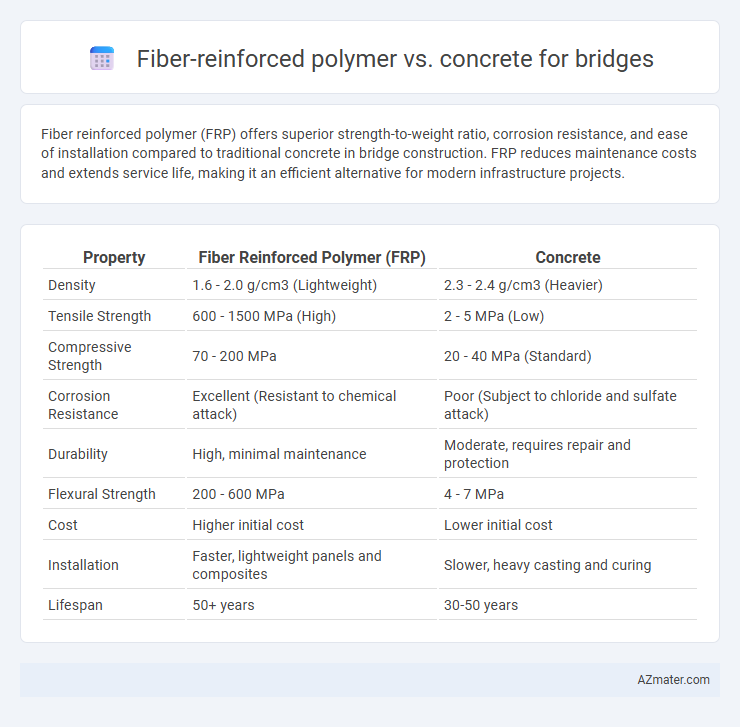Fiber reinforced polymer (FRP) offers superior strength-to-weight ratio, corrosion resistance, and ease of installation compared to traditional concrete in bridge construction. FRP reduces maintenance costs and extends service life, making it an efficient alternative for modern infrastructure projects.
Table of Comparison
| Property | Fiber Reinforced Polymer (FRP) | Concrete |
|---|---|---|
| Density | 1.6 - 2.0 g/cm3 (Lightweight) | 2.3 - 2.4 g/cm3 (Heavier) |
| Tensile Strength | 600 - 1500 MPa (High) | 2 - 5 MPa (Low) |
| Compressive Strength | 70 - 200 MPa | 20 - 40 MPa (Standard) |
| Corrosion Resistance | Excellent (Resistant to chemical attack) | Poor (Subject to chloride and sulfate attack) |
| Durability | High, minimal maintenance | Moderate, requires repair and protection |
| Flexural Strength | 200 - 600 MPa | 4 - 7 MPa |
| Cost | Higher initial cost | Lower initial cost |
| Installation | Faster, lightweight panels and composites | Slower, heavy casting and curing |
| Lifespan | 50+ years | 30-50 years |
Introduction to Bridge Construction Materials
Fiber reinforced polymer (FRP) offers high strength-to-weight ratio and corrosion resistance compared to traditional concrete used in bridge construction materials. Concrete provides excellent compressive strength and durability but is prone to cracking and corrosion, leading to higher maintenance costs. The choice between FRP and concrete significantly impacts structural performance, longevity, and life-cycle costs in bridge engineering.
Overview of Fiber Reinforced Polymer (FRP)
Fiber Reinforced Polymer (FRP) is a composite material made of fibers such as glass, carbon, or aramid embedded in a polymer matrix, offering high strength-to-weight ratio and corrosion resistance. FRP is increasingly used in bridge construction and rehabilitation for its durability, lightweight properties, and ease of installation compared to traditional concrete. Its ability to withstand harsh environmental conditions makes FRP an optimal choice for long-term structural performance and reduced maintenance costs in bridge infrastructures.
Key Properties of Concrete in Bridge Building
Concrete in bridge construction offers high compressive strength and excellent durability, making it ideal for foundational support and load-bearing elements. Its inherent resistance to fire, weathering, and chemical corrosion ensures a long service life with minimal maintenance. The material's versatility allows for varied shapes and sizes, facilitating the design of complex bridge structures with high structural integrity.
Comparative Material Strength: FRP vs Concrete
Fiber Reinforced Polymer (FRP) exhibits superior tensile strength compared to concrete, with tensile capacities often exceeding 1,500 MPa, while concrete tensile strength typically ranges between 2 to 5 MPa. FRP's high strength-to-weight ratio enables lighter bridge components, reducing structural loads and facilitating easier installation. Concrete, although strong in compression with strengths up to 40-50 MPa in standard mixes, lacks FRP's durability in tension and resistance to corrosion, making FRP a preferred choice for enhancing bridge longevity and performance in tension-critical applications.
Durability and Longevity: FRP vs Concrete
Fiber reinforced polymer (FRP) offers superior durability compared to traditional concrete in bridge construction, exhibiting high resistance to corrosion, chemical attacks, and environmental degradation. Concrete, although strong under compression, is prone to cracking, freeze-thaw cycles, and reinforcement corrosion that reduce its lifespan without costly maintenance. FRP bridges typically demonstrate longer service life with lower life-cycle costs due to minimal deterioration, making FRP a more sustainable choice for durable and long-lasting infrastructure.
Cost Analysis: Initial Investment and Lifecycle Costs
Fiber reinforced polymer (FRP) bridges generally incur higher initial investment costs compared to traditional concrete due to advanced materials and manufacturing processes. Lifecycle costs favor FRP bridges as they require less maintenance, resist corrosion, and extend service life, reducing repair and replacement expenses over time. Concrete bridges have lower upfront costs but often face higher lifecycle expenditures from frequent inspections, repairs, and vulnerability to environmental degradation.
Environmental Impact and Sustainability Considerations
Fiber reinforced polymer (FRP) offers significant environmental benefits over traditional concrete in bridge construction, including lower carbon emissions and reduced resource extraction due to its lightweight and durable nature. Concrete production is energy-intensive and contributes substantially to CO2 emissions, while FRP's longer lifespan and corrosion resistance decrease maintenance frequency and waste generation. Sustainable bridge design increasingly favors FRP for its potential to minimize ecological footprint and enhance lifecycle performance in infrastructure projects.
Maintenance Requirements and Repair Procedures
Fiber reinforced polymer (FRP) bridges require significantly lower maintenance compared to traditional concrete bridges due to their superior corrosion resistance and lightweight properties. Repair procedures for FRP structures are faster and less disruptive, typically involving patching or bonding techniques, whereas concrete bridges often demand extensive crack injection, surface sealing, or structural replacement to address deteriorations like spalling and rebar corrosion. The reduced maintenance frequency and simpler repair processes of FRP contribute to longer service life and lower life-cycle costs in bridge applications.
Real-world Applications and Case Studies
Fiber reinforced polymer (FRP) offers superior corrosion resistance and lightweight properties compared to traditional concrete, significantly enhancing bridge durability and reducing maintenance costs. Real-world applications such as the Pearl Harbor Memorial Bridge in Connecticut utilize FRP decks to extend service life under harsh environmental conditions. Case studies reveal that while concrete remains dominant for its compressive strength and cost-effectiveness, FRP integration in repair and retrofit projects improves load capacity and elongates structural lifespan.
Future Trends in Bridge Construction Materials
Fiber reinforced polymer (FRP) offers superior corrosion resistance, lightweight properties, and high tensile strength compared to traditional concrete, making it increasingly favored in future bridge construction. Advances in nanotechnology and hybrid composites are enhancing FRP's durability and cost-efficiency, enabling longer-span bridges and reduced maintenance. Innovations in 3D printing and smart sensor integration with FRP materials are revolutionizing bridge monitoring and adaptive structural performance for safer, more sustainable infrastructure.

Infographic: Fiber reinforced polymer vs Concrete for Bridge
 azmater.com
azmater.com